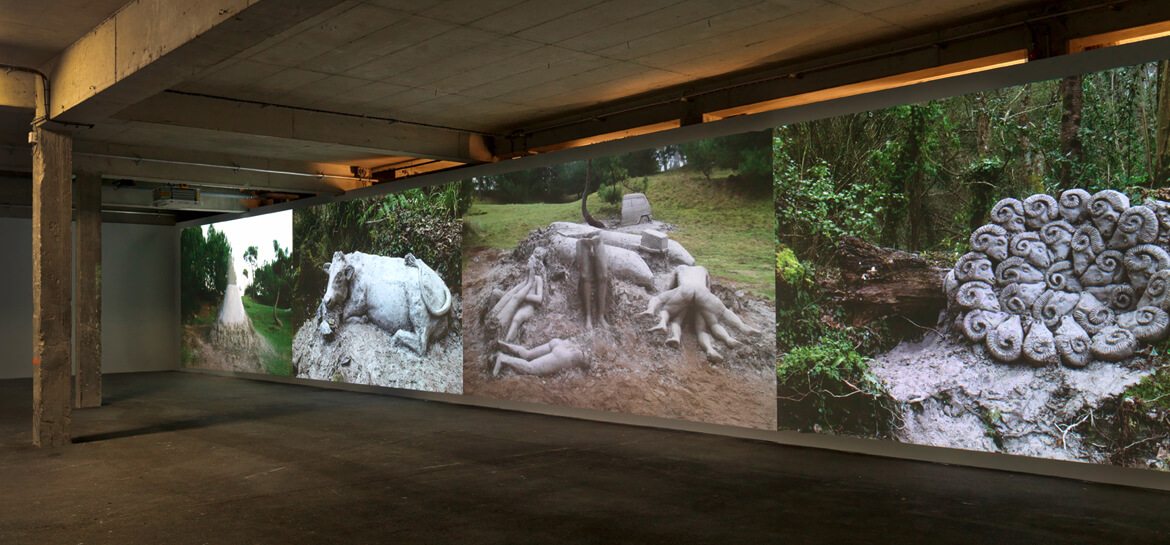SEARCH THE ENTIRE SITE

Daniel Dewar & Grégory Gicquel
Orange juiceAfter “Crêpe Suzette” in Bristol in 2012, it’s time for “Orange Juice” at the Palais de Toyko in 2013. The exhibition is not about food but rather presents the sculptural experiments of Dewar & Gicquel adapted to stop motion film.
After “Crêpe Suzette” in Bristol in 2012, it’s time for “Orange Juice” at the Palais de Toyko in 2013. The exhibition is not about food but rather presents the sculptural experiments of Dewar & Gicquel adapted to stop motion film. The artistic duo – proponents of a “hand-made” approach to their practice which includes wood and stone-carving, ceramics and weaving – have been experimenting with a new medium and giving life to strange sculptures in which pairs of clay legs dancing improbable minuets can be spied amid formless forests and mountains that rise up and collapse.
Reinventing sculpture
From tapestry weaving to granite carving, from chain sawing to firing ceramics, Daniel Dewar and Grégory Gicquel’s (b. respectively in 1976 and 1975, they both live and work in Paris) artistic lexicon creates a joyful— albeit erudite—hodgepodge of types. Though the artists constantly quote pop culture references, thereby casually shrugging off the prevailing aesthetic canons and good taste, they do, however, take their place in the history of sculpture, from its ancient origins to the post-industrial era. The motifs they use throughout their work borrow as much from medieval recumbent effigies as from a form of abstraction developed by certain artists in the latter half of the 20th century. Accordingly, the series Mixed Ceramics (2011) bears resemblances to some of Arman’s archeological sculptures: In both cases, the texture of the found objects indicates a common interest in forms of sedimentation, thus producing a collusion of temporalities.
A new series of video works
For time is precisely at the heart of the short videos recently produced by the intrepid duo. These sequences— undeniably forming a coherent whole—reproduce the precepts of proto-cinema: through the use of stop motion, each of these videos creates the illusion of movement, just like the flip books, thaumatropes and phenakistoscopes of earlier times.
“Deliberately flat yet exciting”
The exhibition takes the viewer through a series of rooms in which sculptures and videos are juxtaposed using a simple setup. Small in size, the ceramics are on the same scale as the video projectors, like tabletop sculptures. The exhibition’s title is made up of a common noun “voluntarily dull yet exciting. An image so simple it becomes absurd” – designating a common exoticism, just like the subjects touched upon by the artists within their sculptural practice. As the art critic Zoë Gray pointed out: “Their multiform process walks a fine line between the sublime and the ridiculous. It is permeated by visualhyperbole; everything is overstated and simultaneously left unsaid.”
Selection of works in the exhibition
Céramics
In a constant effort to put their sculptural practice into perspective, Dewar and Gicquel use ceramic, considered the first „art of fire“. In this way, the artists question the way in which raw materials can be transformed. In these ceramics, the pair employs a technical knowhow (glazing and firing) and craftsmanship (everything is handmade) whose purpose is less to attain a form of perfection than an indirect quest for the representation of the object thus made or found.
Animated GIFS
Projected in a loop, the GIFs animés [Animated GIFs] are short sequences depicting large-scale raw clay sculptures being created in an outdoor setting. These sculptures— reminiscent of the rocks sculpted by Father Fouré at the end of the 19th century in Brittany—come to life thanks to pixilation, a basic animation process with resemblances to pre-cinema techniques. Following a binary rhythm, these GIFs animés [Animated GIFs] have opened up sculpture to a new temporal dimension; a throwback to the rudiments and malleability of the material, they can create movement, like the dance steps of a minuet. More than just videos, these animations are something like the mutation of a unsophisticated image into a sculpture.
With the support of Galerie Loevenbruck (Paris) et de Graff Mourgue d’Algue (Genève).

